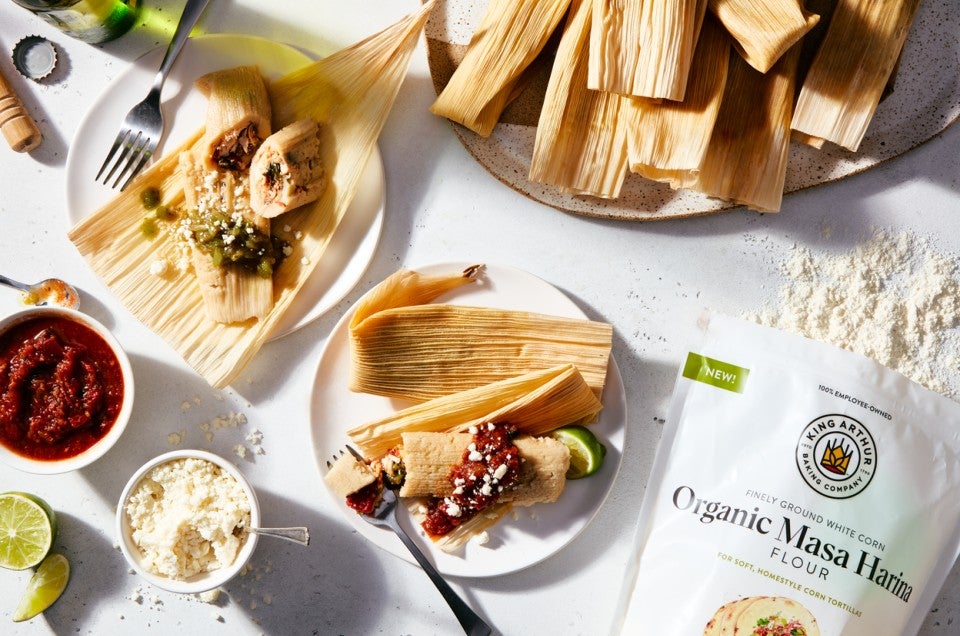Beyond tortillas: four more masa harina favorites to try
These beloved classic recipes range from sweet to savory.


“A gift from the gods.” That’s how renowned Chef Patricia Quintana refers to corn in the pages of her influential cookbook, The Taste of Mexico. She writes, “The ancients ... believed that the gods had molded humans from corn, and the Mexicans, for a time, were known as ‘the men made from corn.’”
A bedrock of Mexican and Central American cuisines, corn is used in nearly every form imaginable. One such iteration is masa harina, a frequent foundation for corn-based dishes and a convenient alternative to fresh masa. It’s a flour made from corn that’s been soaked in a solution of slaked lime (nixtamalized) to loosen its hull and soften it; the soaked corn is ground into a paste (masa), dried, and then ground again, this time into a fine flour. (In fact, the name “masa harina” literally translates to “dough flour.”)
Masa harina might be most frequently associated with tortillas and indeed, it makes soft, flavorful homemade tortillas so tasty you'll eat them straight off the pan. But that’s only one of the many beloved recipes this ingredient is used for. We asked a few bakers and chefs to share some of their favorite masa harina-based dishes, particularly for bakers looking to start putting this ingredient to use in their kitchen.

“Sopes are one of my favorite dishes,” says Sandy Wall, founder of California-based tortilla nonprofit Pueblita. “Whenever I go home to visit my mom and she asks me what I want her to make, 99% of the time I ask for sopes.”
Prepared similarly to tortillas, sopes are thick circles with a raised rim to hold all kinds of delicious toppings. “I would definitely encourage beginners to try them out — from my experience, it’s a hard dish to mess up,” reassures Sandy. “If you're going to make sopes, definitely make the sope shells fresh. The store-bought shells are convenient, but homemade masa and shells really add to the flavor.”
Perhaps the best part, according to Sandy, is that “There are so many different recipes for sopes based on the region of Mexico you’re looking up, which is one of the most fun parts of cooking Mexican food — every region uses different techniques and recipes.”

Meanwhile Dora Stone, of the blog Dora’s Table, says, "If it's your first time using masa harina, I recommend you make gorditas.” She describes them as “a sort of thick tortilla that you cut open and fill," and adds, “They’re really easy to make, and you can fill them with anything. You don't need any kind of special equipment, just your beautiful hands."
To Mexico: The Cookbook author Margarita Carrillo Arronte, who literally wrote a whole book on tamales, the choice was clear. “I’ve made tamales all over the world with masa harina. If you follow a good recipe with baking powder and salt, you have almost a guarantee of success.”

She normally serves them for dinner or breakfast and stresses, “You have to serve them wrapped in their husks or leaves in order to keep them warm and steamy.” When it comes to preparing the recipe, Margarita advises testing if the masa is ready by putting a small amount in a glass of cold water to see if it floats. If it doesn’t float, add more liquid or beat it a little more.
“But nobody’s going to die if it doesn’t float,” says Margarita. “It’s important to lose the fear of tamales.”

Finally, Pati Jinich of Pati’s Mexican Table recommends coricos, a soft, crumbly cookie made with masa harina and most commonly enjoyed throughout northwestern Mexico. “This is a great cookie to nibble on during any time of the day, especially with a cup of coffee or tea or with a glass of cold milk,” she says. “They can be a bit hard to shape, as the masa or dough can crack a bit as you make the rings — don't worry about them looking cracked, as it is part of their charm.” There’s one more benefit to baking them: “This is a great one to make with kids, as they can play with shapes too — this masa is very forgiving.”
Ready to bake? Masa harina is currently available on our website, as well as in select supermarkets nationwide. Consult our product locator for exact locations.
Cover photo by Rick Holbrook.

